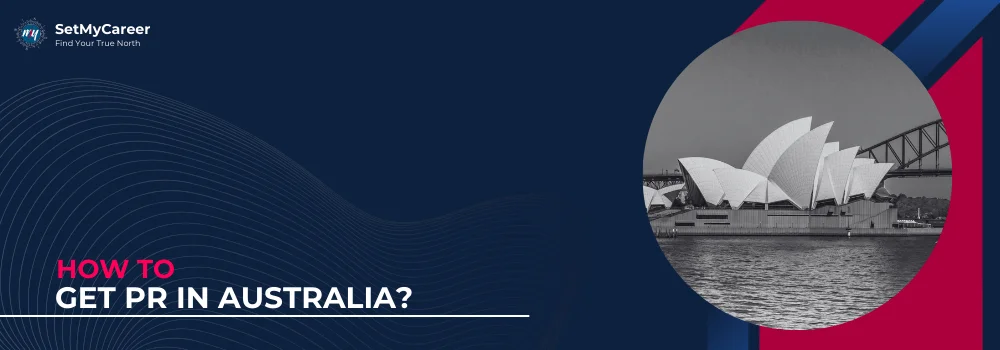
Published by Dr. Nandkishore Rathi on 3 April 2025
Chief Career Navigator
Dr. Nandkishore Rathi is passionate about identifying people's passions and helping them create and lead successful and fulfilling careers. With 30+ years of experience and interactions with thousands of students, academicians, and corporate executives, he has developed a range of career services aimed at benefiting individuals seeking a breakthrough in their professional lives.
From Student to PR: Your Ultimate Guide to Settling in Australia.

So, you’ve fallen in love with Australia—whether it’s the stunning landscapes, vibrant cities, or welcoming culture. Now, you're thinking about making it your permanent home. But let’s be real—getting an Australian Permanent Residency isn’t as simple as packing your bags and hopping on a plane. It’s a structured process that requires careful planning, patience, and the right strategy.
For Indian students, PR offers a golden opportunity to build a successful career and future in Australia. If you're wondering how to transition from being an international student to a permanent resident, this guide will break it down step by step.
Before diving into the process, let’s explore why Australia is one of the most sought-after study abroad destinations for Indian students aiming for PR. Understanding the advantages of choosing Australia over other countries will help you make an informed decision about your future.
World-Class Education: Australia has top-ranked universities that offer globally recognized degrees.
Post-Study Work Opportunities: After completing studies, international students can gain valuable work experience.
High Quality of Life: Australia offers universal healthcare, top-tier education, and a strong economy.
PR as a Pathway to Citizenship: PR status allows you to apply for Australian citizenship after fulfilling residency requirements.
Multicultural Society: Australia is home to a large Indian community, making integration easier.
Many students also consider other destinations like Canada, the UK, and the USA. However, Australia stands out in several ways that make it a top choice for PR hopefuls.
A simpler points-based immigration system compared to the USA’s H-1B lottery system.
Faster PR processing times than Canada in some cases, especially for skilled migration categories.
More post-study work opportunities compared to the UK, which has stricter work visa requirements after graduation.
Lower PR rejection rates compared to countries with highly competitive quotas.
These factors make Australia a top choice for Indian students looking for a smooth transition from studying to permanent residency.

Get your personalised plan with the right course, visa, and work experience for a smooth transition from student to resident.
Plan PRThere are multiple ways to secure PR in Australia, and understanding these options will help you choose the best route based on your qualifications and circumstances.
Study Pathway to PR in Australia
Many Indian students use education as a stepping stone to PR, as it is one of the most accessible and successful pathways, providing a structured route to work experience, skill development, and eventual permanent residency. The key steps include:
Choosing PR-friendly Courses: Some courses have higher PR prospects due to demand in Australia’s workforce.
Post-Study Work Rights (Subclass 485 Visa): Allows students to work in Australia for 2-4 years after graduation.
Gaining Work Experience: Australian work experience can significantly boost PR points.
State Nomination Opportunities: Some Australian states nominate graduates from their universities for PR.
General Skilled Migration (GSM) Pathway
For those with skills in high demand, the GSM pathway is a great option. It allows skilled professionals to apply for PR based on a points system.
Skilled Independent Visa (Subclass 189): No state sponsorship required; based on points.
Skilled Nominated Visa (Subclass 190): Requires nomination by an Australian state or territory.
Skilled Work Regional Visa (Subclass 491): For those willing to live and work in regional areas.
Employer-Sponsored PR
If you have a job offer from an Australian employer, this pathway can lead to PR with the support of your company.
Employer Nomination Scheme (ENS) Visa (Subclass 186): Requires an employer to sponsor you for PR.
Temporary Skill Shortage (TSS) Visa to PR: Work in Australia for a few years before transitioning to PR.
Family-Sponsored PR
If you have close family members who are Australian citizens or PR holders, you may be eligible for PR through family sponsorship.
Partner Visa (Subclass 820/801 or 309/100): For those married to or in a de facto relationship with an Australian citizen or PR holder.
Parent Visa (Subclass 103, 143, or 173): If you have children who are Australian PR holders.
Business and Investment Pathway
For individuals with significant business experience or investment funds, Australia offers PR pathways designed to encourage economic contributions.
Global Talent Visa Program
This program is aimed at highly skilled professionals in specific industries who can contribute to Australia’s economy and innovation sector.
Choosing the right course is crucial for maximizing your PR chances. Here are some fields of study that align well with Australia’s skill shortage lists.
Healthcare & Nursing: High demand across all states.
Engineering: Civil, mechanical, and electrical engineers are in high demand.
Information Technology (IT): Software engineers and cybersecurity experts are sought after.
Accounting & Finance: Helps secure PR under skilled migration.
Trade Courses: Electricians, plumbers, and chefs have great PR prospects.
Social Work & Education: Australia needs skilled professionals in these sectors.
Now, let’s look at how to motivate yourself. Understand that while intelligence has genetic components, lifestyle choices and habits play a crucial role in enhancing cognitive function. Here are some practical and science-backed ways to increase your IQ:
PR applicants are assessed based on a points system. Knowing how to maximize your score can significantly improve your chances of getting PR.
Points are awarded based on:
Age (Maximum points for ages 25-32)
English Proficiency (Higher IELTS/PTE scores give extra points)
Work Experience (Australian work experience is highly valued)
State Sponsorship (Living in certain states can add extra points)
Regional Study Benefits (Studying in regional areas adds bonus points)
While Australia offers multiple pathways to PR, some common challenges can arise. Here’s how to discover them.
High Cut-off Scores: Gain additional points through work experience and regional study.
Visa Rejections & Mistakes: Ensure complete documentation and meet eligibility criteria for visa and processes.
Changing Immigration Policies: Stay updated with Australian immigration rules.
Getting PR in Australia may seem like a long and complicated process, but with proper planning, determination, and strategic decisions, it is absolutely achievable. If you're an Indian student planning to study at a university in Australia, choosing a career, gaining relevant work experience, and maximizing your PR points will set you on the right path.
No. 14/595, 1st Floor, Nanjappa Reddy Layout, Koramangala 8th Block, Bangalore 560095